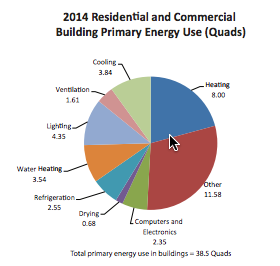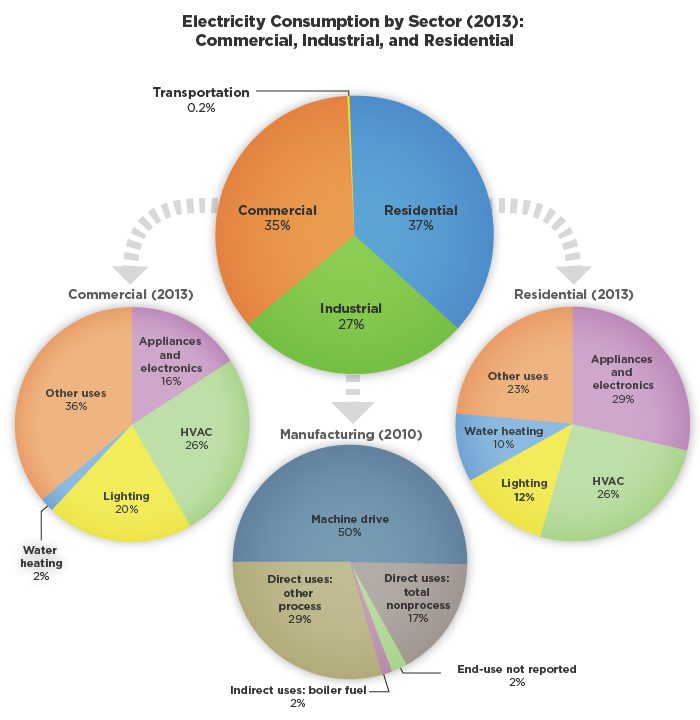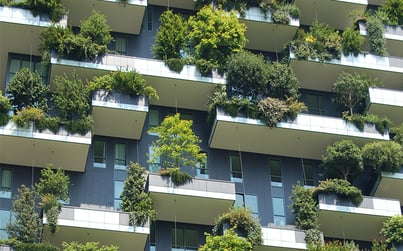Buildings use of electricity has increased over the last several decades and it is now nearly 38% of all US energy. These come from consumption in residential, commercial and manufacturing facilities that are used for lighting and space conditioning, and water heating. The total utility bill for energy used by U.S. buildings topped $450 billion.

Source: Energy.gov
Out of this, more than a third of the energy consumption is by commercial buildings. These include government facilities, public and private buildings and service-providing facilities and equipment.

Source: U.S. Energy Information Administration’s Annual Energy Outlook 2014.
Commercial buildings include offices, schools, hospitals, warehouses, hotels, shopping malls etc.
Energy use in buildings depends on a number of factors like good architecture combined with energy systems design and effective operations and maintenance.
Commercial buildings also spend an average of $1.34 per square foot on electricity and 18 cents per square foot on natural gas.
Energy consumption represents nearly 20% of total energy consumption for a commercial building.
This increased use of energy is concerning for multiple reasons, the primary of which is the increase in energy-related emissions that can have negative consequences of climate change, including higher temperatures and a rise in natural calamities.
The Organization for Economic Co-operation and Development (OECD) warns that, given the current trends, energy-related emissions will increase by 70 percent by 2050 if energy efficiency measures are not in place.
Reducing energy bills, decarbonization, air pollution, and energy consumption should be the goal of every building owner, operator and tenant, especially in the commercial sector.
The key strategy here would be to not just focus on cost-saving activities but maintaining a balance between economic considerations and people’s comfort by optimizing energy sources like lighting, heat, air conditioning and ventilation.
People responsible for the design of the buildings, energy management systems must balance capital costs, energy costs and operational costs along with users’ comfort levels. This involves interactions between investors, architects, owners, engineers, property manager and tenants and ensuring all their goals are met while achieving energy efficiency goals.
Here we will take a look at the benefits of energy efficiency and why it is required.
We will cover some of the methods you can use to achieve energy efficiency in your buildings and, finally, how SMART buildings can be used as an important method to meet your energy efficiency goals.
Benefits of energy efficiency
Attention to energy efficiency is on the rise both nationally as well as internationally as a key resource in economic and social development. Energy efficiency is also a huge goal for the global economic development. The United Nations Sustainable Energy for all initiative further defines this.
There are multiple benefits of energy efficiency beyond the reduction in energy consumption, reducing associated costs and greenhouse emissions.
1. Economic Development: For commercial buildings, the most important benefit of energy efficiency is a lower cost of building operations. They bring direct savings to the energy bills, save on increasing rent due to decreased expenses and improve conditions for the tenants.
The value of the buildings, though difficult to assess, is also co-related to better energy performance. Evidence suggests that energy efficient buildings show shorter vacancy periods, have lower tenant turn-over and show a positive operating impact for the owner.
Commercial buildings that fail to keep up with the technological advances in energy efficiency risk becoming obsolete especially in unfavorable market conditions like low or negative economic growth. Studies have shown that better performing buildings can attract an increased sale value of between +5.2% and +35% in the commercial sector. This corresponds to an increase in rental values from +2.5% to +11.8% for commercial buildings.
International Energy Agency (IEA) has studied macroeconomic impact of energy efficiency closely. Changes due to energy efficiency have shown a GDP growth rate ranging from 0.25% to 1.1%. On the employment front, one modeling study shows that each EUR 1 million invested in energy efficiency creates 8 to 27 job years.
2. Public Health: Energy efficiency helps improve the health, safety and comfort of building residents.
Energy efficiency measures like improving insulation, heating, cooling and lighting systems support warmer, drier and comfortable indoor environment. This has a direct impact such as lowered risk of illness and with indirect physical health benefits. But evidence goes beyond physical health: energy efficiency measures can alleviate the mental health burdens often associated with cold homes, including the financial stress of high energy bills.
Three main factors related to indoor environments that have major impacts on human health and well-being are i) thermal quality, ii) air quality, and iii) mold caused by dampness.
The most prominent health impacts associated with energy efficiency improvements include reduced respiratory disease symptoms and lower
rates of excess winter mortality (EWM) in cold climates. Fewer deaths from dehydration are reported in heat extremes.
3. Environmental Impact: Commercial buildings are responsible for 35% of total GHG emissions such as CO2 that have an adverse impact on the environment and climate change.
By installing more energy efficient systems and reducing the energy consumption of these buildings, cities can reduce greenhouse gas emissions, improve the outdoor environment locally and globally, and ensure a better future for generations to come.
Reduced emissions of CO2, CO, Ozone and Sulphur Dioxide have a direct impact on air quality, increasing global temperature, rising sea levels as well as an increase in natural calamities.
Energy efficiency is the only practical way for climate change mitigation.
Reducing consumption of energy like reduced electricity affects the amount of electricity power plants have consume, subsequently reducing the fossil fuels that are burnt each day.
In addition to impacting climate change and depleting natural resources,
Energy efficiency has an indirect effect on animals and ecosystems.
Human-induced air pollution is one of the main reasons that biodiversity is disappearing at 1,000 times the normal extinction rate.
Energy Efficiency Measures
The following are some of the measures that can be implemented in a commercial building:
Equipment:
• Operating existing equipment well according to its operating speed and load control and replacing old parts help with higher efficiency.
• Data and monitoring of the equipment for voltage regulation, phase balancing and preventive maintenance help to reduce technical losses with increased reliability.
Operations:
• Operations include routine data collection, regular analysis of energy performance, replacement and upgrade of faulty parts.
• Operations should be in accordance to design standards, heat losses minimized by good insulation, waste heat recovered for use elsewhere in the plant.
Building Design:
• Utilization of modern construction methods and materials that help with air circulation and ventilation. Windows and building surfaces with tunable optical properties.
• Lighting – High-efficiency green LEDs, Sensors for lighting control
• Electronics – Utilizing sensors wherever possible. Advanced circuitry, improved control systems, efficient software to operate the building.
BEMS:
To ensure that all the rooms and space of the building are operated at an optimal level, property managers and building owners should install advanced automation and control systems like BEMS (Building Energy Management Systems).
BEMS helps in achieving a comfortable internal environment for the tenants while optimizing energy consumption.
BEMS is a computer-controlled system that helps in monitoring and controlling the building’s energy use with the goal of optimizing energy efficiency. Cables connect the plant through a series of hubs called outstations around the building back to a central supervisor computer where building operators can control the building.
The software provides control functions, monitoring, alarms and allows the operators to optimize building performance. BEMS are a critical component to managing energy demand, particularly in large complex buildings and multi-building sites.
They typically come with a user interface where you can monitor regular usage in detail and the granularity that you need.
Through the use of intelligent controls, BEMS can control the building’s internal environment without causing discomfort to the tenants.
SMART Building Management System: An advanced BEMS is called the SMART building system where most of the programs are automated that helps in reducing downtime as well as operations cost.
SMART systems have automated diagnostic and fault detection as well as set points and set timers. These systems not only provide energy efficiency but they are regularly making recommendations or changes for continuous improvement.
A SMART BMS also helps with scheduling maintenance activities like ensuring lighting; HVAC systems are automatically turned On and Off when tenants are not present in the buildings.
They also provide additional benefits like energy sharing, where multiple tenants of a building can set their goals and track their energy consumption.
They also provide Energy Demand Management wherein it automatically manages power consumption to avoid exceeding set energy consumption limits or incurring fines.
Conclusion:
In conclusion, energy efficiency is no longer optional in buildings. It is delivering significant and multiple benefits not only in reducing energy costs but also elevating human lives and environment.
There are multiple ways to achieve energy efficiency that range from simple measures like operating equipment as per design to complex computer-based systems like Building Energy Management Systems.
Whatever is the means, building energy efficiency measures are on the rise with increased awareness of its economic and social value.
Looking for more information on building efficiency? Check out our eBook: How to Combat Building Obsolescence. Download now.


